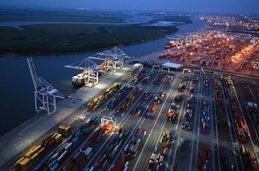
China’s economic slowdown is affecting most global markets. The seaports along the US eastern seaboard are no different. Most are experiencing a drop in exports for China consumers and materials used in the manufacturing of goods. Port authority executives expect flat to modest growth in trade with China.
“Overall, I believe China’s economy is unfortunately a drag on all major markets due to its increasingly important role in the global economy,” says Curtis Foltz, executive director, Georgia Ports Authority (GPA).
Nevertheless, Foltz maintains that the GPA “has and will continue to remain a dominant player in the Asian trades,” which represent 70% of its activity.
“Taking a long-term view of capital spending to increase capacity and throughput and targeting the fast-growing Southeast US market will ensure our ports are the gateway choice for goods shipped between the US Southeast and Asia,” he says.
GPA achieved record container volumes in 2015. Over the last calendar year, the Port of Savannah moved an all-time-high 3.73 million TEUs, an increase of 391,356 TEUs, or 11.7% growth compared to calendar year 2014.
“The expansion was fuelled in part by heightened demand in the US Southeast, Savannah’s logistical advantages drawing new customers to Georgia, and cargo diverted from the West Coast,” says Foltz.
To increase port efficiency, the GPA board recently approved the purchase of four new ship-to-shore cranes for the Port of Savannah, bringing its total to 30. These machines can reach across vessels 22 containers wide and lift cargo weighing up to 72 tons to a height of 152 feet above the dock. Each crane weighs 1,388 tons and measures 433 feet wide and 185 feet tall.
“Even before the new cranes arrive, Savannah has more cranes on its nearly two-mile-long dock than any other single terminal in North America,” Foltz says.
The cranes represent a US$47 million investment, which cranes will arrive in late spring 2018, The additions are part of the board’s Focus 2026 Capital Plan, which calls for 34 ship-to-shore cranes at its Garden City Terminal.
The South Carolina Ports Authority (SCPA) posted 10% container growth in 2015, a year highlighted by strong volumes and significant progress on the harbour-deepening project. SCPA handled 144,718 TEUs in December, pushing total container volume to 1.97 million in 2015.
The Port of Charleston is SCPA’s container seaport.
Jim Newsome, SCPA president and CEO, called the 10% TEU volume growth “outstanding,” adding: “Successful recruitment of discretionary cargo has been an important driver of volumes, as well as continued strength of the automotive sector.”
Looking ahead to the second half of our 2016 fiscal year, Newsome expects flat to very modest growth due largely to weakness in overseas markets. “Because of the Panama Canal expansion delay, we will not see new ship deployments of significance until fiscal year 2017,” he says.
Newsome says that the overall slowing of the Chinese economy is a factor in the more moderate export container volume growth rates this year over last year.
“Global container trade has slowed since last year, and we remain focused on controlling what we can – high productivity and reliability at a relatively low cost to shippers,” he says. “We have 10 weekly Asian services and offer an ideal proximity to growing import markets for Asian commodities, which is enhanced by our inland port. Our deepwater harbour also allows Charleston to be the last port of call for vessels heavy-loaded with exports.”
Particularly key to keeping SCPA’s Port of Charleston competitive in the future is the Post 45 Harbor Deepening Project that will deepen the Charleston Harbour to 52 feet. The project has progressed quickly as the first study completed entirely through the US Army Corps of Engineers SMART Planning process. The USACE’s original estimate of seven years and US$20 million dollars for the study and associated environmental reviews and permits was nearly cut in half to four years and US$11 million as a result of the new programme, as well as collaboration with state and federal partner agencies.
The Port of Virginia set a new annual record for container cargo volume, having handled more than 2.5 million TEUs in 2015, a 6.5% increase over last year’s total. Nevertheless, Joe Harris, Virginia Port Authority (VPA) spokesman, says that the Port of Virginia is seeing slow-growth in many of its trade lanes.
“But we are still growing,” he adds. “Our fiscal year-to-date volumes, as of January, are up nearly 3%, and we are forecasting a strong cargo performance in February,” he says.
To remain competitive in Asia, the Port of Virginia retains sales representatives in mainland China and Hong Kong who are engaged with existing and new customers. “We are marketing our capabilities – deepwater, modern terminals, double-stack rail to important Midwest manufacturing and population centres – and making sure that existing and new customers clearly understand the short- and long-term benefits of moving cargo across the Port of Virginia,” he says.
John F. Reinhart, CEO and executive director of VPA, says the port is now focused on the future, adding capacity and cargo conveyance equipment, making greater use of technology and strategic planning. “We will continue to examine our operational practices, reinvest in the facilities and equipment and overall, look for ways to continue to improve service and velocity,” he says.
Further north, the Port of Baltimore and Seagirt Marine Terminal are averaging a US-leading 75 container moves per hour per berth – a rate faster than all other major American ports.
Recently, Maersk Line, the world’s largest container shipping company, began serving the Port of Baltimore. Wallenius Wilhelmsen Logistics, the port’s largest roll on/roll off customer, also signed a new 30-year contract to continue calling on Maryland.
By Karen E. Thuermer
Correspondent | Washington




